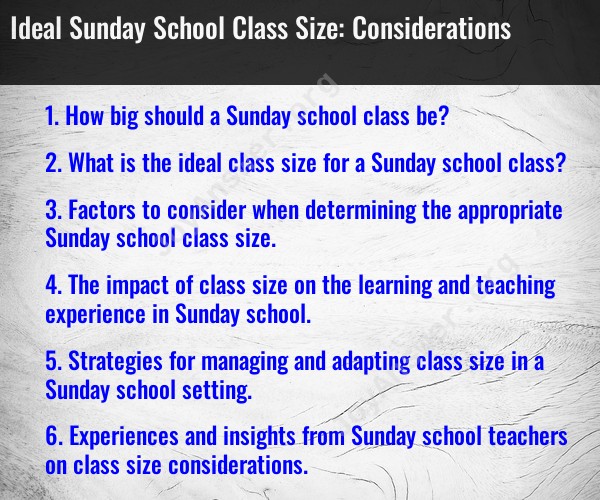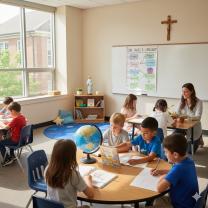How big should a Sunday school class be?
The ideal size for a Sunday school class can vary depending on several factors, and there is no one-size-fits-all answer. The appropriate class size depends on the specific goals, resources, and preferences of the church or religious organization, as well as the age group and needs of the students. Here are some considerations when determining the ideal Sunday school class size:
Age Group: The ideal class size may differ for children, teenagers, and adults. Young children often benefit from smaller classes with more individual attention, while adults may be more comfortable in larger groups.
Space: Consider the physical space available. A larger room can accommodate more students, but overcrowding can be uncomfortable. Ensure that the space allows for a conducive learning environment.
Teacher-Student Ratio: An important consideration is the teacher-student ratio. Smaller classes generally allow for more individualized instruction, but you may need more teachers or volunteers to maintain a low ratio.
Student Needs: Some students may require more attention and support than others. Special needs students, for instance, might benefit from smaller classes to address their specific requirements.
Interaction and Engagement: Smaller classes often facilitate more student interaction and engagement, which can be beneficial for discussions and group activities. However, larger classes can offer diverse perspectives and opportunities for group dynamics.
Resources: Consider the availability of resources, such as teaching materials and volunteers. Smaller classes may be more manageable in terms of resource allocation.
Church Size and Goals: The size of the church and its overall goals for the Sunday school program can also influence class size. Larger churches may have the capacity for larger classes, while smaller congregations may prefer more intimate settings.
Flexibility: Some churches opt for a flexible approach, where class sizes may vary depending on attendance on a given Sunday. This allows for adaptation based on attendance patterns.
Feedback: It's important to seek feedback from both teachers and students to determine their preferences and needs regarding class size. This input can help make informed decisions.
Safety and COVID-19 Considerations: In light of health and safety concerns, it's important to consider class size in the context of the COVID-19 pandemic. Health guidelines and recommendations should be followed to ensure the safety of participants.
In general, a balance between smaller and larger classes can be beneficial. Smaller classes can provide a more personalized and interactive experience, while larger classes can offer a sense of community and diversity. Ultimately, the ideal Sunday school class size should be determined in consideration of the unique circumstances and goals of the church or religious organization. Regular evaluation and adjustments based on feedback can help optimize the learning experience for students.
What is the ideal class size for a Sunday school class?
The ideal class size for a Sunday school class is one that allows for effective teaching and learning. This means that the teacher is able to give each student the attention they need, and that students have the opportunity to participate in class discussions and activities.
There is no one-size-fits-all answer to the question of ideal class size, as it will vary depending on a number of factors, such as the age group of the students, the teaching style of the teacher, and the resources available. However, most experts agree that a class size of 10-20 students is ideal.
Factors to consider when determining the appropriate Sunday school class size.
Some of the factors to consider when determining the appropriate Sunday school class size include:
- Age group: Younger students may require more attention from the teacher, so smaller class sizes are often ideal for this age group.
- Teaching style: Some teachers prefer to teach smaller classes, while others are comfortable teaching larger classes.
- Resources available: The size of the classroom and the availability of teaching materials may also limit the number of students in a class.
- Learning goals: If the goal is to promote student participation and discussion, a smaller class size may be ideal. However, if the goal is to deliver information to a large number of students, a larger class size may be more appropriate.
The impact of class size on the learning and teaching experience in Sunday school.
Class size can have a significant impact on the learning and teaching experience in Sunday school. Smaller class sizes can lead to:
- More individualized attention for students
- More opportunities for student participation and discussion
- A more positive and supportive learning environment
Larger class sizes can lead to:
- Less individualized attention for students
- Fewer opportunities for student participation and discussion
- A more challenging learning environment for some students
It is important to note that class size is not the only factor that affects the learning and teaching experience in Sunday school. Other factors, such as the teacher's qualifications, the quality of the teaching materials, and the motivation of the students, also play a role.
Strategies for managing and adapting class size in a Sunday school setting.
There are a number of strategies that Sunday school leaders can use to manage and adapt class size:
- Offer multiple class times: This can help to spread out the students and reduce class sizes.
- Divide the class into smaller groups for activities: This can give students more opportunities to participate and learn from each other.
- Use technology to facilitate learning: For example, teachers can use online learning platforms or video conferencing to connect with students in different locations.
- Recruit and train more teachers: This can help to reduce class sizes and allow teachers to give each student the attention they need.
Experiences and insights from Sunday school teachers on class size considerations.
Sunday school teachers often have valuable insights into the impact of class size on the learning and teaching experience. Here are some of their experiences and insights:
- "I prefer to teach smaller classes because I can give each student more individualized attention."
- "Larger classes can be more challenging to manage, but it is rewarding to see so many students learning and growing together."
- "I find that it is helpful to divide the class into smaller groups for activities. This gives students more opportunities to participate and learn from each other."
- "I use technology to connect with students who are unable to attend class in person. This allows me to reach a larger number of students and provide them with the opportunity to learn about God's Word."
Ultimately, the best way to determine the ideal class size for your Sunday school is to consider the needs of your students, the resources available, and your learning goals.












